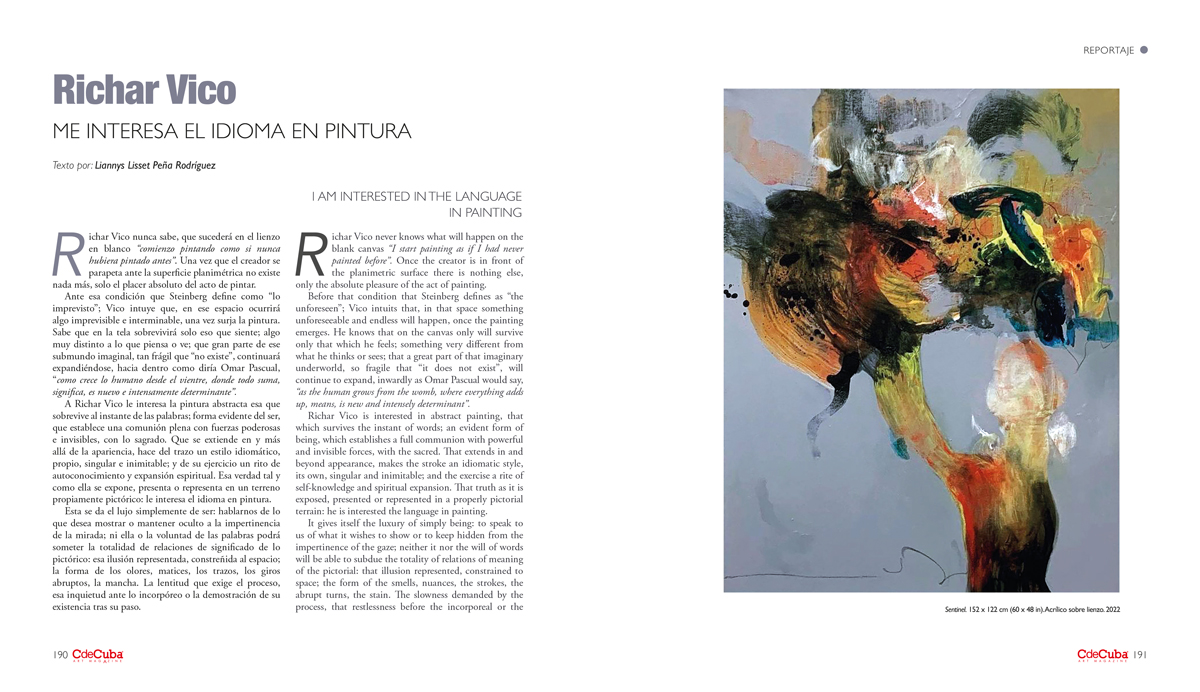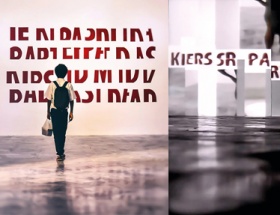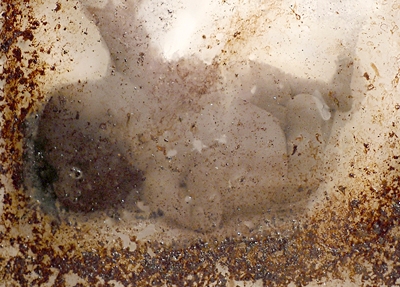I am Interested in the Language in Painting
By Liannys Lisset Peña Rodríguez
Richar Vico never knows what will happen on the blank canvas “I start painting as if I had never painted before”. Once the creator is in front of the planimetric surface there is nothing else, only the absolute pleasure of the act of painting.
Before that condition that Steinberg defines as “the unforeseen”; Vico intuits that, in that space something unforeseeable and endless will happen, once the painting emerges. He knows that on the canvas only will survive only that which he feels; something very different from what he thinks or sees; that a great part of that imaginary underworld, so fragile that “it does not exist”, will continue to expand, inwardly as Omar Pascual would say, “as the human grows from the womb, where everything adds up, means, is new and intensely determinant”.
Richar Vico is interested in abstract painting, that which survives the instant of words; an evident form of being, which establishes a full communion with powerful and invisible forces, with the sacred. That extends in and beyond appearance, makes the stroke an idiomatic style, its own, singular and inimitable; and the exercise a rite of self-knowledge and spiritual expansion. That truth as it is exposed, presented or represented in a properly pictorial terrain: he is interested the language in painting.
It gives itself the luxury of simply being: to speak to us of what it wishes to show or to keep hidden from the impertinence of the gaze; neither it nor the will of words will be able to subdue the totality of relations of meaning of the pictorial: that illusion represented, constrained to space; the form of the smells, nuances, the strokes, the abrupt turns, the stain. The slowness demanded by the process, that restlessness before the incorporeal or the demonstration of its existence after its passage.
The plastic ornamentation becomes evident: juxtaposes elements that make up the physical part of the work; related materials that form on that unique and static two-dimensional surface, plastic-iconic signs, systems from which articulates the cognitive process. Large stains, as a support for the occurrence of metonymy close to synecdoche: that unleashing of the different poses of the pigment, the body of the object impregnated in paint in contact with the canvas leaves behind a plastic effect that refers to and in a certain sense replaces the fact or structure that provoked it.
The material gains corporeality by accentuating itself in concise brushstrokes or drips, with the rhythmic intention of hypertexturizing certain areas. Sweeps, dripping, transparencies; elements that expand the limits of painting, whose moldability is so fleeting that the artist personalizes it according to his intentions. In each work they are perfected until they leave the way open to new speculations about the concept and intention of the pictorial. Experimentation and research that make the planimetric support a sort of resonance field, of heartbeats that sustain that pictorial mass that extends indefinitely before us.
The plastic scenes are built from the accumulation: addition of elements or expressive blocks of color. Moving away from the canvas towards the retina, the rhythm increases, the turns become more violent, practically left to chance: unmeasurable movement that the soul exercises in an uncontrolled way.
It is through the gesture that the space becomes visible, establishes prudent distances, from an optical replay. A sensation of volume or spatiality; which is generated from the contrast of large masses of pigment with areas of emptiness, a resource that makes the work betray, at times, its spontaneous nature and shows us as a serene, conscious construction, even within the expressions of freedom that are evident.
Another reason that makes me maintain that there is a balanced relationship between intuition, experimentation and pictorial wisdom; certain traits sustain that not all the process is left to chance. The composition is structured from the relations of spatial order, inclusive, modular; of subordination and coordination, which frame the presence of emptiness between the forms and chromatic rhythms; without the precondition to horror vacui, which can overwhelm the surfaces.
However, the knowledgeable observer comes to reveal that in the first phases, the artist conceives a particular structure in pursuit of an internal harmony that intervenes with a certain order within the chaos: these large stains are very important a posteriori. They affect the surface of the unprotected canvas before the pigment, like glazes and organize the composition, the chromatic balance that sustains the relationships in the work, forming a personal calligraphy; which makes it particular within the universe of contemporary abstraction.
And this is what happens when the language is spoken in painting: the involuntary disposition to new senses and treatment to the truths of and about the pictorial; because a language, if it exists is that “the possibility of the games, the detours, the equivocations” as it happens in Richar Vico’s painting, once the stroke expands on the canvas; this ductus (language of the stroke) that emerges from the interior towards the hand is visualized as an unplanned way of externalizing the most intimate “I”, united to a deep knowledge of that relative notion of truth that drags behind painting.






